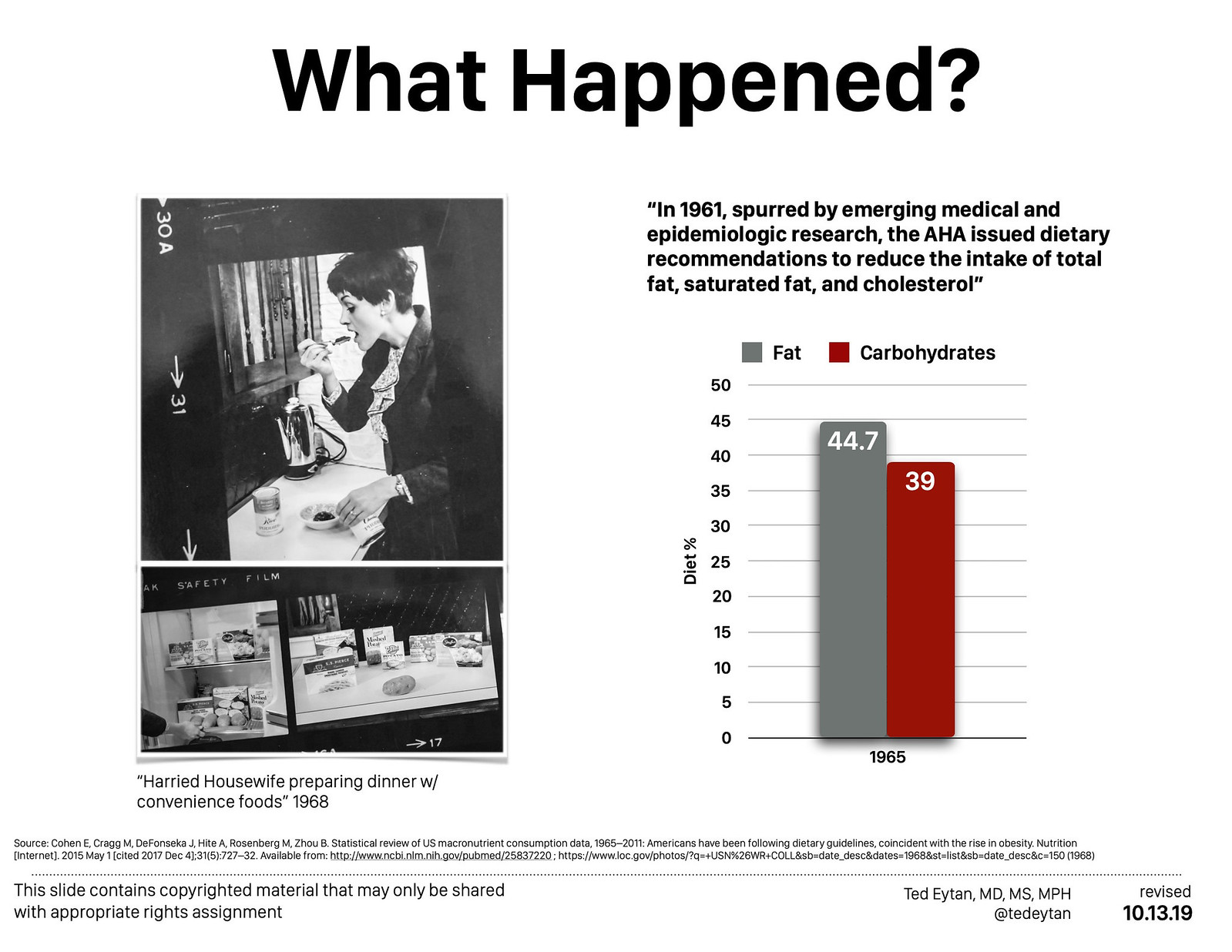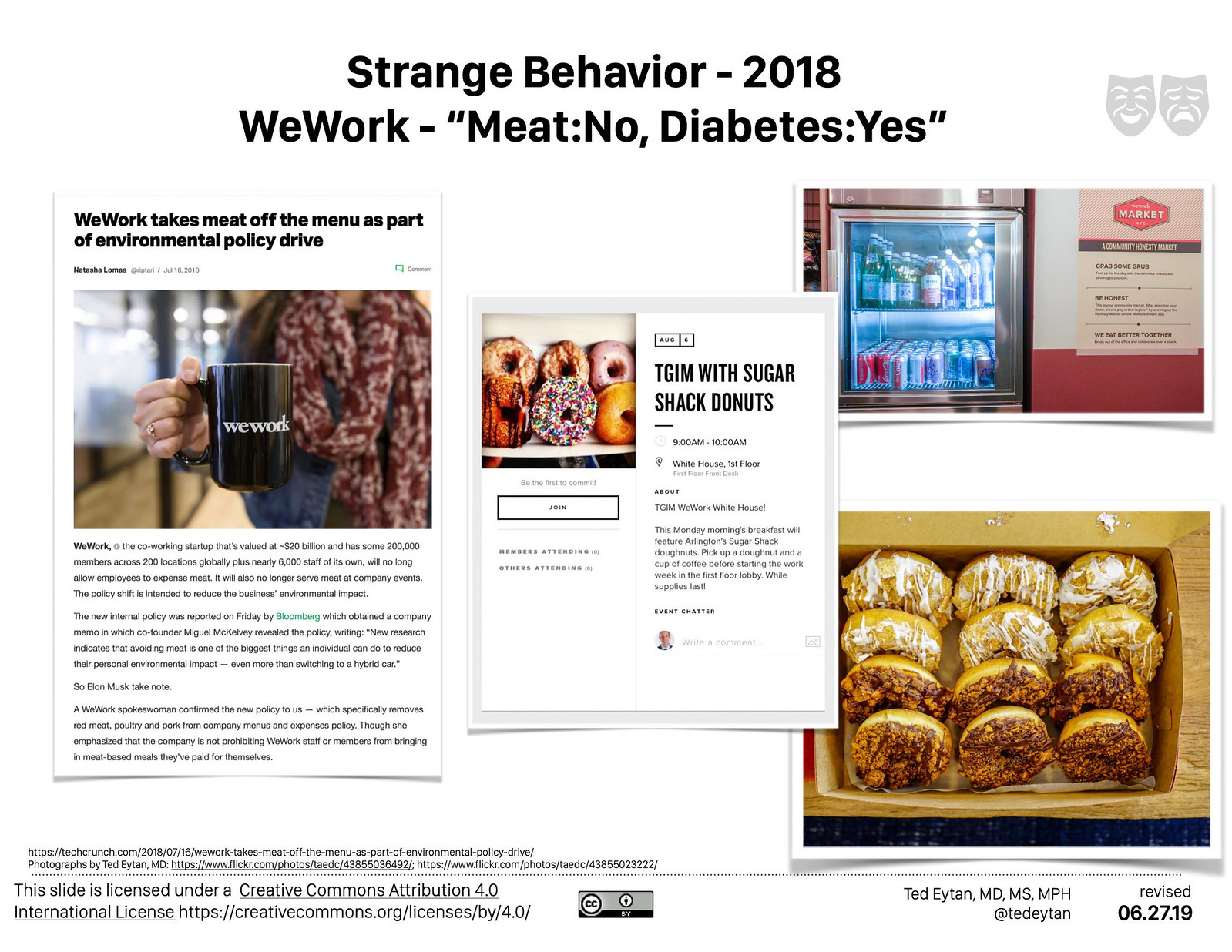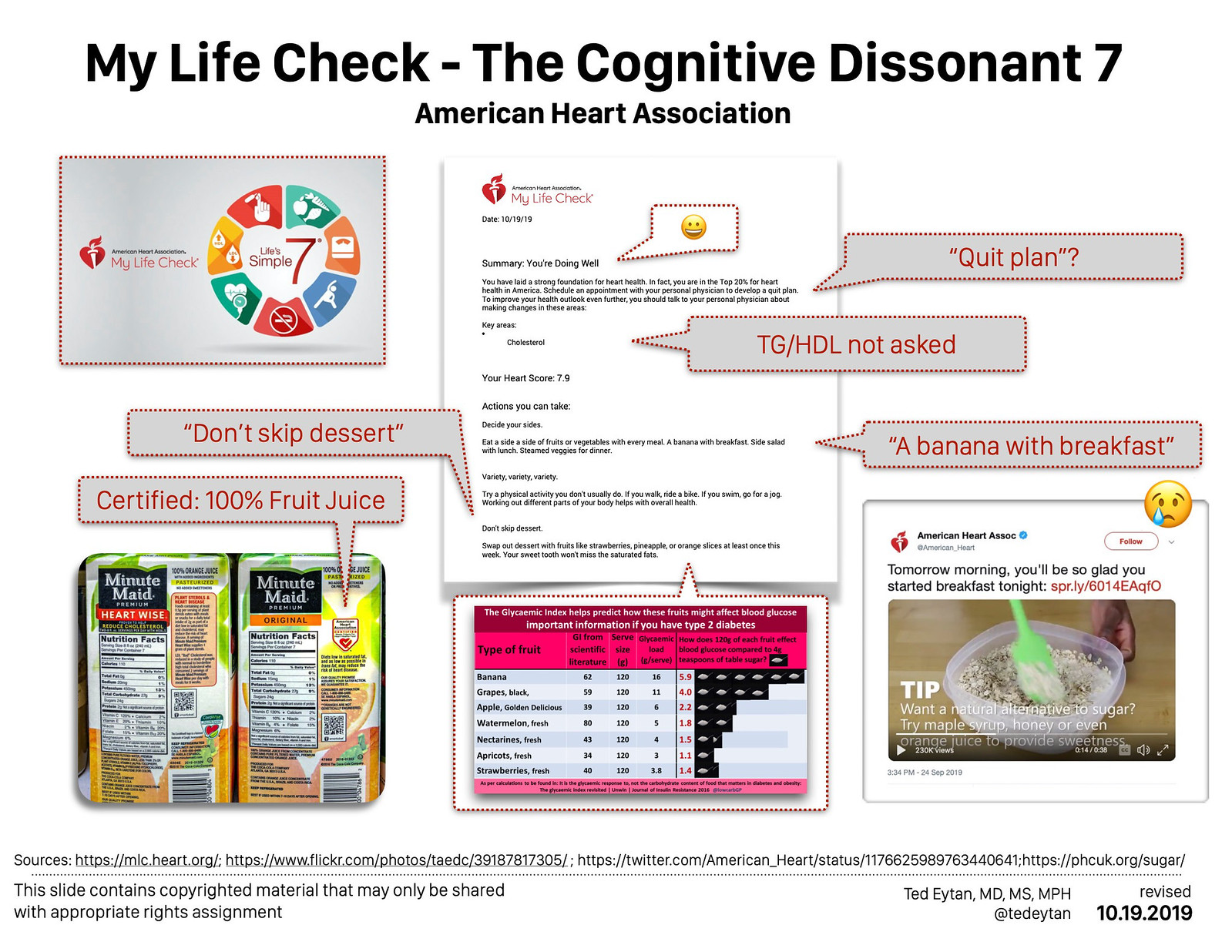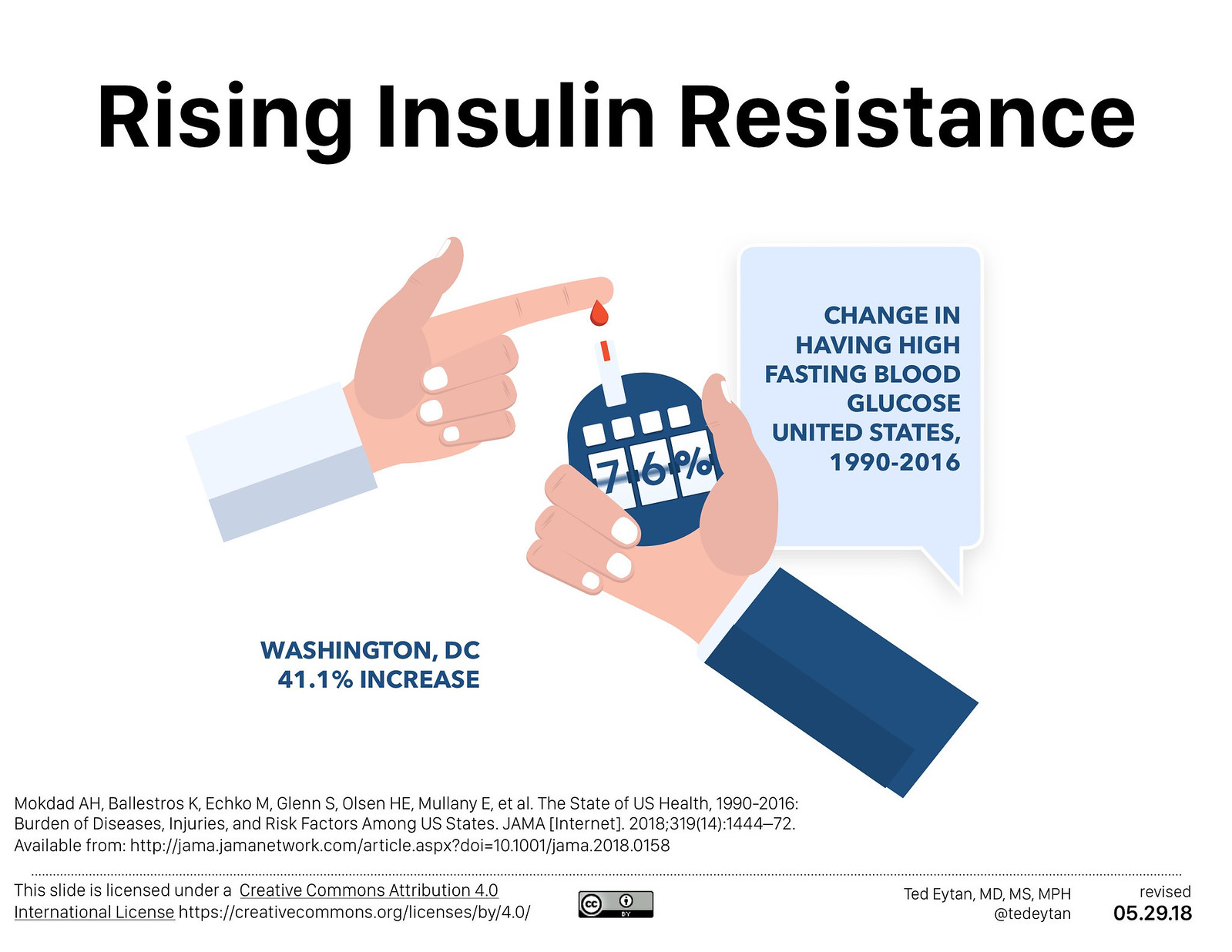
This paper is a review of the dietary habits of Americans from 1999 – 2016, a follow-up from a previous analysis, using the NHANES database.
As the chart above shows:
- As of 2015, the majority of energy in a typical American’s diet comes from carbohydrates (50.5%), 83.2% of them considered low quality. This has gone down slightly from 85.7 % in 1999.
- Total percent of energy from low quality carbohydrate sources: 41.8 %
A recap of how we got here
In 1961, spurred by emerging medical and epidemiologic research, the AHA issued dietary recommendations to reduce the intake of total fat, saturated fat, and cholesterol.Cohen E, Cragg M, DeFonseka J, Hite A, Rosenberg M, Zhou B. Statistical review of US macronutrient consumption data, 1965–2011: Americans have been following dietary guidelines, coincident with the rise in obesity. Nutrition [Internet]. 2015 May 1 [cited 2017 Dec 4];31(5):727–32. Available from: http://www.ncbi.nlm.nih.gov/pubmed/25837220

…the shift in the share of fat and carbohydrate is primarily due to an almost 65 g, or about a 260 kcal, daily increase in Americans’ intake of carbohydrate from 1965 to 2011.Cohen E, Cragg M, DeFonseka J, Hite A, Rosenberg M, Zhou B. Statistical review of US macronutrient consumption data, 1965–2011: Americans have been following dietary guidelines, coincident with the rise in obesity. Nutrition [Internet]. 2015 May 1 [cited 2017 Dec 4];31(5):727–32. Available from: http://www.ncbi.nlm.nih.gov/pubmed/25837220

There is a strong relationship between the increase in carbohydrate share of total intake and obesity. This is reflected by the high correlation at the individual level between caloric share from carbohydrate and adult BMI: 85.3% for men and 91.2% for women.Cohen E, Cragg M, DeFonseka J, Hite A, Rosenberg M, Zhou B. Statistical review of US macronutrient consumption data, 1965–2011: Americans have been following dietary guidelines, coincident with the rise in obesity. Nutrition [Internet]. 2015 May 1 [cited 2017 Dec 4];31(5):727–32. Available from: http://www.ncbi.nlm.nih.gov/pubmed/25837220

After 2000, shifts in scientific evidence and dietary guidelines promoted health benefits of healthy fats and plant sources of protein and the harms of low-quality carbohydrates.Shan Z, Rehm CD, Rogers G, Ruan M, Wang DD, Hu FB, et al. Trends in Dietary Carbohydrate, Protein, and Fat Intake and Diet Quality Among US Adults, 1999-2016. JAMA [Internet]. 2019 Sep 24 [cited 2019 Sep 30];322(12):1178. Available from: https://jamanetwork.com/journals/jama/fullarticle/2751719

Reason to hope for better adherence (?)
The attached editorial says the following:
The evidence of some improvement in diet quality reported by Shan and colleagues offers reasons to hope that continued national,local,and individual efforts encouraging population-wide adherence to the US Dietary Guidelines for Americans could subsequently improve health and delay onset of chronic disease.1. Van Horn L, Cornelis MC. US Dietary Guidance—Is It Working? JAMA [Internet]. 2019 Sep 24;322(12):1150. Available from: https://jamanetwork.com/journals/jama/fullarticle/2751694
41 years later, this is what hope looks like in everyday life






Conflicts of Interest Disclosed
I’d call them “numerous”
For the first reference (Shan Z, Rehm CD, Rogers G, Ruan M, Wang DD, Hu FB, et al. Trends in Dietary Carbohydrate, Protein, and Fat Intake and Diet Quality Among US Adults, 1999-2016):
Dr Rehm reported receipt of personal fees from Nestec Ltd and the Dairy Management Institute. Dr Hu reported receipt of grants from the CaliforniaWalnut Commission and personal fees from Metagenics, Standard Process, and Diet Quality Photo Navigation. Dr Mozaffarian reported receipt of grants from the Gates Foundation; receipt of personal fees from GOED, Nutrition Impact, Pollock Communications, Bunge, Indigo Agriculture, Amarin, Acasti Pharma, Cleveland Clinic Foundation, America’s Test Kitchen, and Danone; scientific advisory board membership from Elysium Health (with stock options), Omada Health, and DayTwo; and receipt of publication royalties from UpToDate; in addition, Dr Mozaffarian reported holding patents US8889739 and US9987243 listing Dr Mozaffarian as a coinventor for use of transpalmitoleic acid to prevent and treat insulin resistance, type 2 diabetes, and related conditions as well as reduce metabolic risk factors. No other disclosures were reported.
For a previous reference related to this work
Since this issue is coming up in other venues for other studies, I noted this conflict of interest from one of the authors for previous work on this topic. I would also call these significant conflicts.
Dr Mozaffarian reported receiving honoraria from Nutrition Impact, Haas Avocado Board, Amarin, and AstraZeneca; personal fees from Bunge, Life Sciences Research Organization, and Boston Heart Diagnostics; serving on advisory boards for Unilever North America (ended 2014); and chapter royalties from UpToDate. No other disclosures were reported Rehm CD, Peñalvo JL, Afshin A, Mozaffarian D. Dietary intake among US Adults, 1999-2012. JAMA – J Am Med Assoc [Internet]. 2016 Jun 21;315(23):2542–53. Available from: http://jama.jamanetwork.com/article.aspx?doi=10.1001/jama.2016.7491
My Conflicts of Interest
You can access these on my disclosures page. Short version, I have none.
References
- Shan Z, Rehm CD, Rogers G, Ruan M, Wang DD, Hu FB, et al. Trends in Dietary Carbohydrate, Protein, and Fat Intake and Diet Quality Among US Adults, 1999-2016. JAMA [Internet]. 2019 Sep 24 [cited 2019 Sep 30];322(12):1178. Available from: https://jamanetwork.com/journals/jama/fullarticle/2751719
- Cohen E, Cragg M, DeFonseka J, Hite A, Rosenberg M, Zhou B. Statistical review of US macronutrient consumption data, 1965–2011: Americans have been following dietary guidelines, coincident with the rise in obesity. Nutrition [Internet]. 2015 May 1 [cited 2017 Dec 4];31(5):727–32. Available from: http://www.ncbi.nlm.nih.gov/pubmed/25837220
- https://www.ers.usda.gov/amber-waves/2016/december/a-look-at-calorie-sources-in-the-american-diet/
- https://www.flickr.com/photos/29069717@N02/10821800065